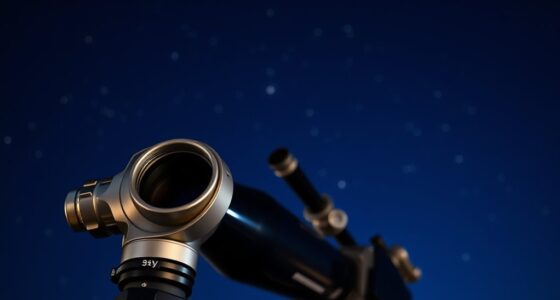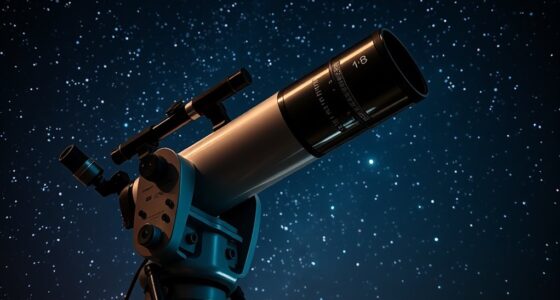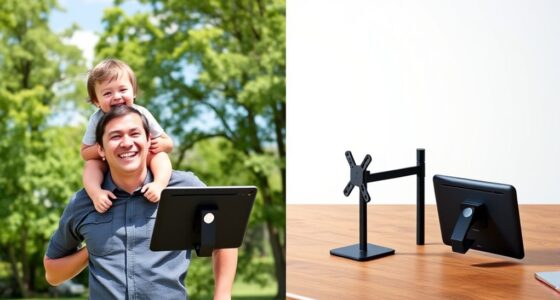To balance your telescope for smooth tracking, start by attaching all accessories securely and positioning them as you would during use. Adjust the counterweights along the shaft until the scope stays level and moves with minimal resistance. Check balance in both altitude and azimuth axes, making sure the mount stays steady at different angles. Keep testing by moving the scope around; fine-tune as needed. If you want to master perfect balancing, there’s more to discover ahead.
Key Takeaways
- Attach all accessories securely and position them as during actual use to ensure accurate balance.
- Adjust counterweights along the shaft until the telescope remains balanced with minimal effort.
- Check and balance both altitude and azimuth axes by repositioning weights and mount components.
- Test the telescope’s stability through various positions to identify and correct any drifting or resistance.
- Regularly revisit and fine-tune the balance to maintain smooth tracking and prevent motor strain.

Balancing a telescope is an essential step to guarantee smooth and accurate tracking of celestial objects. When you set up your telescope, it’s important to pay close attention to how the mounting accessories are arranged and how the weight is distributed. Proper balancing reduces strain on your mount’s motors and ensures that your telescope moves smoothly through the night sky. If your telescope isn’t balanced correctly, you might experience jerky movements, difficulty in tracking objects, or even damage to your gear over time.
Start by examining your mount and the attached accessories. Your mounting accessories, such as finderscopes, cameras, or guide scopes, add extra weight that can throw off the balance if not properly managed. Before you begin balancing, make sure all accessories are securely attached and positioned as they would be during actual use. This way, you replicate the real conditions and achieve an accurate balance. Remember that even small accessories can affect the overall weight distribution, so include everything you plan to use during your session.
Next, adjust the counterweights on your mount. These weights are designed to counteract the weight of your telescope and accessories. Slide the counterweights along the shaft until the telescope balances freely with minimal effort. When you gently release the telescope from a slightly tilted position, it should stay in place without drifting downward or swinging upward. If it moves easily in either direction, keep adjusting the counterweights until you find that perfect balance point. It’s essential that the weight distribution feels even on both axes, preventing unnecessary strain on the motors and gears.
Don’t forget to check the balance in both axes—altitude and azimuth. For altitude, adjust the counterweights to ensure the telescope stays level when pointed at different angles. For azimuth, reposition the mount or accessories if needed to keep everything centered and balanced horizontally. Properly balancing in both directions minimizes resistance and makes manual adjustments smoother, which is especially helpful when tracking objects for extended periods.
Finally, once you think you’ve achieved balance, move your telescope through different positions to test it. If it remains stable and moves easily without wobbling or resistance, you’ve done a good job. If it drifts or feels heavy in certain directions, revisit the mounting accessories and weight distribution. Regularly checking and adjusting your balance ensures your telescope performs at its best, providing you with smooth tracking and a more enjoyable stargazing experience. Additionally, maintaining proper lifestyle habits like routine checks can prolong the lifespan of your gear and improve overall observation quality.
Frequently Asked Questions
How Often Should I Check My Telescope’s Balance?
You should check your telescope’s balance every few sessions or if you notice tracking issues. During an alignment check, make certain the counterweight adjustment is still correct, especially after moving or transporting your telescope. Regularly verifying the balance helps maintain smooth tracking and prevents strain on motors. Adjust the counterweight as needed to keep the telescope balanced, making your stargazing sessions more enjoyable and accurate.
Can Improper Balancing Damage My Telescope?
Improper balancing can definitely damage your telescope. If your telescope isn’t properly balanced, it puts extra strain on the mount’s motor and gears, risking misalignment and mechanical failure. It can also affect mount stability, causing shaky images or even dropping your equipment. To protect your telescope and guarantee precise observations, always check your balance regularly, especially after adjustments, and maintain proper telescope alignment for smooth tracking and longevity.
What Tools Are Needed to Balance My Telescope?
Did you know that improper balancing can cause your telescope to drift by up to 15%? To achieve perfect balance, you’ll need simple tools like a counterweight adjustment knob or screw, and maybe a small level for tilt balancing. These help you fine-tune your telescope’s weight distribution, ensuring smooth tracking. Keep a sturdy wrench or Allen key handy for adjustments, so you can easily stabilize your setup for ideal viewing.
Does Balancing Differ Between Motorized and Manual Telescopes?
Balancing your telescope differs mainly in how you perform counterweight adjustments and mount calibration. For motorized scopes, you fine-tune counterweights to guarantee smooth motor operation and prevent strain on the gears. Manual scopes require precise mount calibration, so you modify counterweights until movement feels effortless. In both cases, proper balance minimizes vibrations and improves tracking, making your observing experience more enjoyable. Always double-check your counterweight adjustments before observing.
How Does Temperature Affect Telescope Balance?
Temperature changes affect your telescope’s balance through thermal expansion and variations in ambient temperature. As it gets warmer, metal parts expand slightly, which can cause your telescope to become unbalanced. Conversely, cooler temperatures cause contraction, also impacting balance. To maintain smooth tracking, regularly check and adjust your telescope’s balance as ambient temperatures fluctuate, especially during long observing sessions or when moving between different environments.
Conclusion
Now that your telescope is perfectly balanced, you’ll enjoy smooth, steady tracking through the night sky—no more frustrating jitters or missed details. Remember, just like an artist’s brush gliding effortlessly across a canvas, a well-balanced telescope moves seamlessly with your gaze. So, take this moment to appreciate your craftsmanship, like a sailor adjusting his rigging under a starry sky. With patience and practice, your stargazing experience will be as timeless as the constellations themselves.








